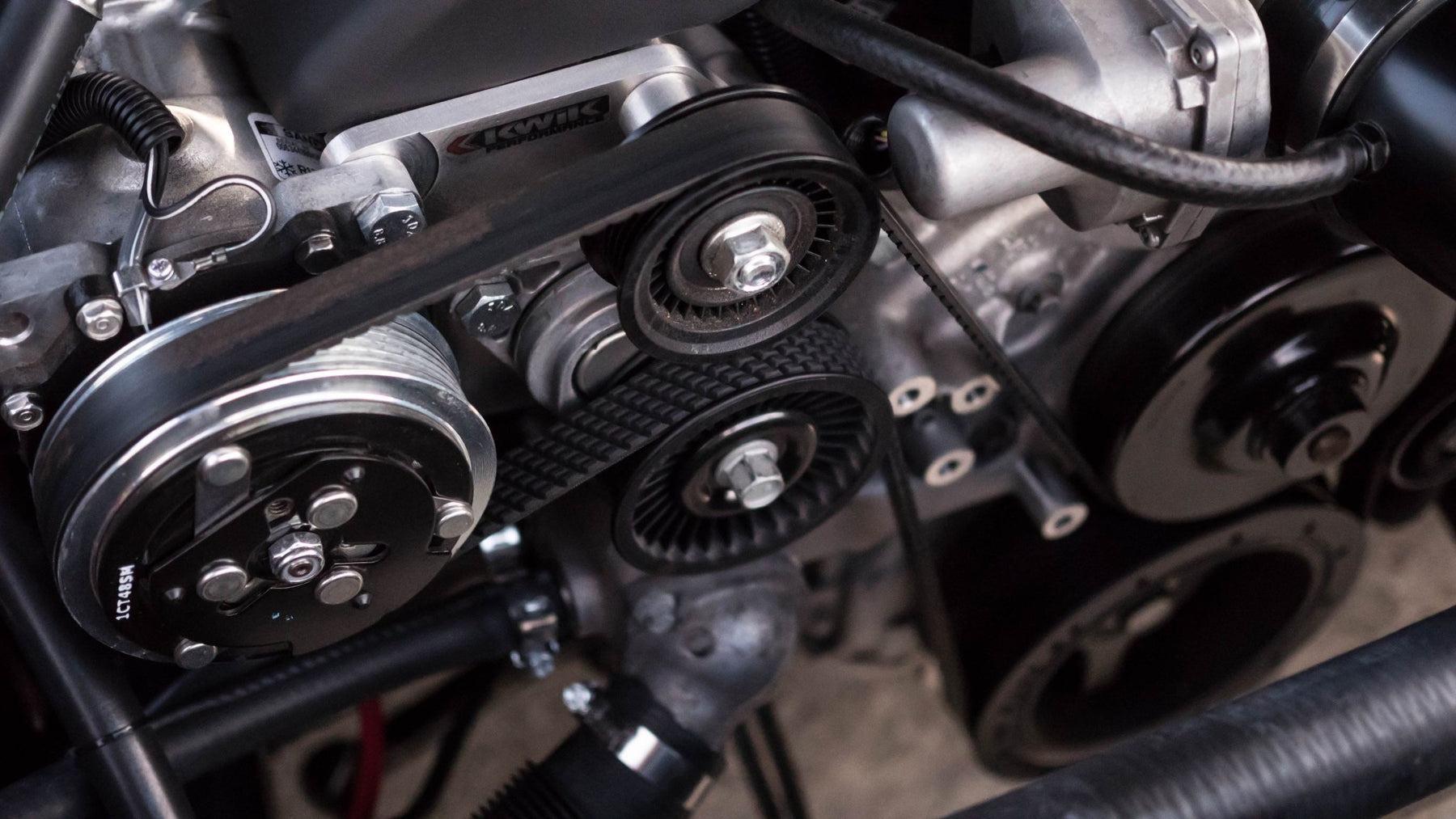4.6 Rating | 95% Recommend ⭐️⭐️⭐️⭐️⭐️

How Tight Should a Serpentine Belt Be? Complete Guide to Serpentine Belt Tension
How tight should a serpentine belt be? If you’re concerned about serpentine belt tension and seeking answers, you’ve come to the right place. This in-depth guide will cover everything you need to know to install and maintain your serpentine belt and finally enjoy peace of mind!
In considering all the various systems of your vehicle that are dependent on the serpentine belt (power steering pump, water pump, alternator, etc.), it goes without saying that proper serpentine belt tension cannot be overlooked.
With that said, finding the sweet spot between “too tight” and “too loose” isn’t as easy as you may think. But we’ll help you find clarity on the topic in just a moment so you can feel confident checking the tension on your system.
Below, we’ll guide you through how to check tension on serpentine belts while explaining exactly how tight a serpentine belt should be. We’ll also offer a few invaluable insights on how to optimize your serpentine belt performance and ensure longevity. First, allow us to set the stage by explaining why serpentine belt tension cannot be overlooked.
Why Serpentine Belt Tension Cannot Be Overlooked
The tension of your serpentine belt is a critical factor in its performance and longevity.
If the belt is too loose, it may slip or squeal, reducing its ability to drive engine accessories and potentially causing damage to the belt and other components. If the belt is too tight, it can cause excessive wear on the belt, pulleys, and bearings, leading to premature failure of these components.
Below we’ll expand on the risks associated with improper serpentine belt tension - starting with when the serpentine belt is too tight.
What Happens if the Serpentine Belt is Too Tight
- Excessive Wear: A serpentine belt that is too tight can cause excessive wear on the belt and other components, leading to premature failure. The added tension can cause the rubber on the belt to wear down more quickly, which can cause the belt to crack or break.
- Increased Stress on Pulleys: When a serpentine belt is too tight, it can place extra stress on the pulleys and bearings that it drives. This added stress can cause these components to wear out more quickly, which can lead to further damage and potentially expensive repairs. This isn’t just true of the serpentine system itself - but the components it drives - like the alternator, power steering pump, and water pump.
- Increased Friction: An excessively tight serpent belt can cause increased friction between the belt and the pulleys. This friction can cause the belt to heat up and wear down more quickly, which can lead to premature failure.
All of these can be summed up as damage to the belt itself or the surrounding systems. In other words - a serpentine belt being too tight is a problem! But so too is a loose belt - here’s why…
What Happens if the Serpentine Belt is Too Loose
- Slipping: A serpentine belt that is too loose may slip or squeal, which can cause a loss of power to engine accessories. This can lead to reduced performance and potentially cause damage to the belt and other components.
- Reduced Accessory Performance: A serpentine belt that is too loose may not be able to drive engine accessories at their full capacity. This can lead to reduced performance of these accessories, which can impact the overall performance of the vehicle. Some of these components include the power steering pump, the water pump, and the alternator.
- Premature Wear: A serpentine belt that is too loose can cause excessive wear on the belt and other components - just as a serpentine belt that’s too tight can. The belt may not be able to maintain proper tension, which can cause it to bounce or vibrate, leading to premature wear and potentially costly repairs.
All of this is to say that finding the sweet spot between “too tight” and “too loose” is paramount to the performance and longevity of your serpentine belt. But, how tight should a serpentine belt be? Find out by reading below…
So, How Tight Should a Serpentine Belt Be?
Now that we’ve explained why this isn’t something you should take lightly, it’s time to get into what you really came here for. How tight should a serpentine belt be for optimal performance and a long, reliable life?
As with most components on your vehicle, the answer isn’t one size fits all. The proper tension will depend on several factors, including the make and model of the vehicle, the type of belt, and the number and size of accessories driven by the belt. As such, you’ll need to take our recommendation with a grain of salt and do a bit more research into your specific vehicle/belt/other systems.
In general, though, tension lower than ½” is considered too loose - and tension over ½” is considered too tight. That’s the sweet spot to shoot for.
But what does this mean exactly? How can you check the tension of your serpentine belt to see where it currently stands? You don’t need to take your vehicle into a shop - learning how to check tension on serpentine belts is actually fairly straightforward. We’ll break it down below.
How to Check Tension on Serpentine Belt (Plus, How to Loosen or Tighten the Serpentine Belt if Necessary)
Now that you know how tight a serpentine belt should be, we want to guide you step by step through checking the tension. Then, we’ll offer tips on adjusting the belt’s tension if necessary. First things first - get all the necessary supplies:
Step 1) Get the Proper Supplies
As with any repair/inspection, we recommend first getting the right PPE and the tools for the job. The basics include eye protection and work gloves. You may want to wear coveralls so you don’t get any belt grease or grime on your clothing.
As for actually checking the tension of serpentine belts, you can take two approaches:
- Using a sophisticated serpentine belt tension gauge
- Going the old-fashioned way with a ruler, socket wrench/set, screwdriver/pry bar, and a torque wrench
If you’re a gearhead, a tension gauge is a great investment. If not, there’s no sense in investing in one if you already have the other tools we mentioned on hand. We’ll provide advice on both methods below.
Step 2) Locate the Serpentine Belt
Your serpentine belt lives at the front of the engine and has a pulley attached to it. Look up images of your specific engine make/model if you’re having trouble finding the belt.
Step 3) Check the Belt’s Tension
Now comes the fun part - actually checking the tension of your serpentine belt. If you have a tension gauge, this is easy. Place the gauge on the belt in the middle of the longest span between two pulleys.
Then, apply pressure to the belt tension gauge by rotating the gauge handle or using a wrench to turn the gauge bolt. Keep applying pressure until the gauge indicates the proper amount of tension. Take your reading and assess whether it’s within the guidelines we provided earlier (½”) or whatever your manufacturer recommended.
If you’re not using a belt tension gauge, you’ll follow a somewhat similar procedure and find the longest stretch of the belt. Press down on it with your hand while placing the ruler against the belt and measuring how far it moves.
At this point, you know whether your serpentine belt is too tight, too loose, or just right. If you’re in the sweet spot, then great - your work is done. If not, keep reading to learn how to tighten the serpentine belt or how to loosen serpentine belts.
Step 4) Adust the Belt’s Tension if Necessary
You’ll now want to find the serpentine belt tensioner pulley and loosen the bolt. It’s worth noting that there are likely multiple tensioner pulleys in your engine bay - so take care to find the right one associated with your serpentine belt.
After loosening that bolt (without removing it completely), you will be able to move the tensioner up or down depending on whether you’re attempting to tighten or loosen the belt. After making the adjustment, you can tighten the bolt and recheck the tension to ensure you’ve got it dialed in.
Other Ways to Optimize Serpentine Belt Performance & Ensure Longevity
There you have it - how to check tension on serpentine belts along with the steps necessary to adjust the tension if necessary. That wasn’t so bad, was it? This simple process can help extend the life of your serpentine system while ensuring peak performance.
But, if you want to push the limits of your vehicle’s performance even further, you can upgrade to a high-performance serpentine belt kit at Southwest Performance Parts. Our auto parts are the perfect balance of high-end performance and affordability - something you’ll have a hard time finding at other suppliers. This is only possible because we manufacture these parts ourselves under the dependable A-Team brand and then sell them directly to you.
In our catalog, you’ll gain access to SBC serpentine belts, SBF serpentine belts, LS serpentine kits, BBC serpentine kits, and BBF serpentine kits. No matter your make/model, we have the perfect system to improve your car’s performance, reliability, and appearance. And if you’re not sure which kit is right for you, or you want advice on making the upgrade, don’t hesitate to reach out!
Wrapping Up Our Serpentine Belt Tension Guidelines
It’s time to wrap up our guide to serpentine belt tension. We’ve answered some of the most common questions surrounding this important topic - like how tight should a serpentine belt be. We’ve also explained how to check tension on the serpentine belt while providing tips on how to tighten the serpentine belt if necessary.
By now, you should feel confident in lifting the hood and taking a look at your belt’s tension. Doing this every so often will prevent early failure while ensuring your belt is performing to its best abilities. So, grab your tools and get to work assessing your serpentine belt tension today!


